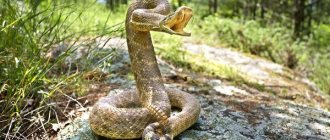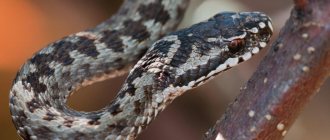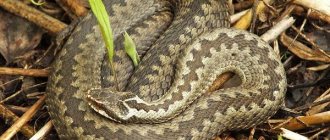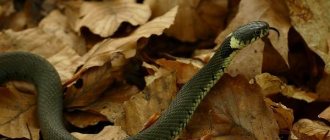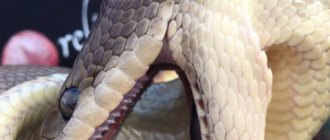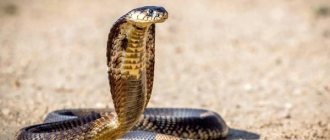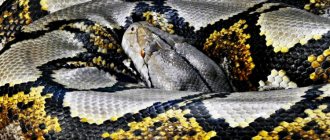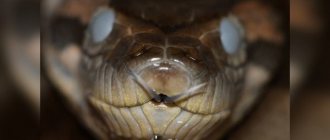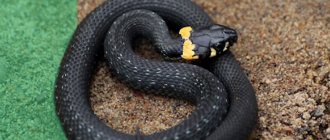For many, just the mention of a rattlesnake evokes horror. An encounter with this reptile can end very sadly. The snake makes a lightning-fast throw, digs its sharp teeth into the flesh of the victim and injects deadly poison into its body. If you do not consult a doctor in time, a person begins to experience arrhythmia, breathing becomes impaired, and bronchospasm occurs, which leads to death.
However, avoiding a collision with a dangerous reptile is easy. Nature has endowed it with a rattle (or rattle), with which the predator warns potential enemies of its location. When you hear a characteristic sound, you just need to move away. What is this rattle? How does it work? What snakes have it?
Description and features
According to the main version, a rattlesnake uses a rattle to warn and scare away enemies. The design of the sound instrument is quite simple. When shedding, a section of keratin plates forms at the tip of the tail. The sequence of these sections creates a structure capable of sound: a rattle, a rattle.
Special, shaking muscles shake the tip of the tail with a frequency of about 50 Hz. Vibration activates the rattle. This explains why the rattlesnake is called the rattlesnake .
The number of times a snake sheds depends on the availability of food and its growth rate. When the old skin is shed, the ratchet grows another segment. Old sections may fall away. That is, the size of the ratchet does not indicate the age of the snake.
Scientists believe that the main feature of these snakes is not the ability to chatter, but the presence of two infrared sensors. They are located in the pits on the head, between the eyes and nostrils. Therefore, from the family of vipers, rattlesnakes were separated into the subfamily of pit vipers.
Infrared sensors operate over a short distance. About 30-40 cm. This is enough to make night hunting for warm-blooded animals successful. Infrared receptors are very sensitive. They detect a temperature difference of 0.003 °C. They can work independently or assist the eyes, increasing image clarity in very low light.
The eyes of rattlesnakes, like infrared sensors, are designed to work in the dark. But rattlers' eyesight is weak. It captures movement. It is difficult to distinguish stationary objects.
Unlike vision, snakes’ sense of smell is excellent. In the process of detecting smell, the nostrils and the snake's tongue work, which delivers odorous molecules to the peripheral organs of the olfactory system.
Snakes do not have external ears. The middle ear does not perceive sound well. Focused on the perception of soil vibrations transmitted through the skeletal system. Rattlesnake fangs contain ducts that are connected to venom glands.
At the moment of the bite, the muscles located around the glands contract and the poison is injected into the victim. The system for generating poison and killing victims works from birth. Behind the existing fangs there are spare ones. In case of loss, poisonous teeth are replaced.
Beanbag
All rattlers have an unusual rattle at the end of their tail. It is a series of keratin plates formed during molting. When a reptile sheds its skin, some of the dead scales remain on the body. They form a growth. Over time, several of them accumulate.
However, it cannot be said that the length of the rattle depends on the number of molts or on the age of the snake. The fact is that old keratin plates regularly fall off, and new ones appear in their place. When in danger, the reptile's shaking muscles begin to vibrate. This causes the tip of the tail to vibrate. In this case, the keratin plates rub against each other, which produces a characteristic sound. That's why reptiles are called rattlers.
Menshikov and his young beautiful wife: why the couple has no children
American husband Mika Newton: how the singer, who emigrated to the USA, lives now
Nature generously endowed Ossetians with magical beauty: photo
Lifestyle and habitat
America is the homeland of rattlesnakes. The northern border of the range is southwestern Canada. South - Argentina. Especially many species of rattlesnake inhabit Mexico, Texas and Arizona.
Being cold-blooded animals, they have increased demands on the temperature environment. Basically, the rattlesnake lives in places where the average temperature is 26-32 °C. But it can withstand short-term temperature drops down to -15 °C.
During the cold months, when temperatures are below 10-12 °C, snakes enter a hibernation-like state. Scientists call it brumation. Snakes gather in large numbers (up to 1000 specimens) in crevices and caves. Where they fall into suspended animation and wait out the cold season. At the same time, these reptiles awakened can organize an entire invasion of rattlesnakes .
Habitat[edit]
The loreal fossa is clearly visible below and anterior to the eye (below and posterior to the nostril).
Crotalines are a diverse subfamily whose members are found in a variety of habitats from the parched desert (e.g. Sidewinder, Crotalus cerastes
) to tropical forests (e.g. bushmaster,
Lachesis muta
).
They can be either arboreal or terrestrial, and one species is even semi-aquatic: the cottonmouth, Agkistrodon piscivorus
.
The altitude record is held jointly by Crotalus triseriatus
in Mexico and
Gloydius strauchi
in China, both of which were found above tree line above 4000 m.[6]
Nutrition
The menu of rattlesnakes includes small animals, including rodents, insects, birds, and lizards. The main method of hunting is waiting for prey in ambush. When potential prey appears, it lunges and injures the unwary animal with a toxic bite.
Rattlesnake venom is the main and only weapon. After killing comes the crucial moment of swallowing the victim. The process always starts from the head. In this version, the paws and wings are pressed against the body and the entire swallowed object takes on a more compact appearance.
The digestive system copes even with indigestible foods. But this takes time and the snake crawls away and settles in a place that is safe, from its point of view. The digestion process works best at a temperature of 25 to 30 °C. Snakes need water. The body gets most of its moisture from caught and swallowed animals. But there is not always enough liquid.
Like most animals, snakes cannot drink. They lower the lower jaw into the water and, through the capillaries located in the mouth, drive moisture into the body. It is believed that in order to fully exist, a snake needs to consume as much liquid per year as it weighs.
Links[edit]
- ^ ab MacDiarmid RW, Campbell JA, Touré T (1999). Snake Species of the World: A Taxonomic and Geographical Guide, Volume 1
. Washington, DC: League of Herpetologists. 511 p. ISBN 1-893777-00-6 (series). ISBN 1-893777-01-4 (volume). - ^ ab Mehrtens JM (1987). Living snakes of the world in color
. New York: Sterling Publishers. 480 pp. ISBN 0-8069-6460-X. - Sometimes spelled "pitvipers" - Campbell & Lamar, 2004 [ relevant page
] - κρόταλον. Liddell, Henry George; Scott, Robert; The Greek-English Lexicon
at the Perseus Project. - "Crotalinae". Integrated Taxonomic Information System. Retrieved October 26, 2006.
- ^ a b c d Campbell J. A., Lamar W. S. (2004). Venomous reptiles of the Western Hemisphere
. Ithaca and London: Comstock Publishing Associates. 870 pp., 1500 sheets. ISBN 0-8014-4141-2. - Parker HW, Grandison AGC (1977). Snakes - natural history
. Second edition. London and Ithaca: British Museum (Natural History) and Cornell University Press. 108 pages 16 plates. LCCCN 76-54625. ISBN 0-8014-1095-9 (fabric), ISBN 0-8014-9164-9 (paper). - Bullock TH, Diecke FPJ (1956). "Properties of the infrared receptor." Journal of Physiology 134
: 47–87. - Stidworthy J (1974). Snakes of the world
. New York: Grosset & Dunlap Inc., 160 pp. ISBN 0-448-11856-4. - Jump up
↑ Shine R, Sun L, Kearney M, Fitzgerald M (2002).
"Why do juvenile
Chinese pit vipers (
Gloydius shedoaensis
)
choose tree ambush sites
?"
Ethology 108
: 897–910. ISSN 0179-1613. PDF Archived 24 July 2008 at the Wayback Machine at the School of Biological Sciences, University of Sydney. Accessed October 26, 2006
Reproduction and lifespan
Females are ready for procreation at 6-7 years, males at 3-4 years. An adult male can engage in mating games every year, the female is ready to prolong the genus once every three years. The mating season for rattlesnakes can range from late spring to early fall. It all depends on the type of snake and the characteristics of the territory in which they live.
Demonstrating readiness for procreation, the female begins to secrete a small amount of pheromones. A trail of these odorous substances remains behind the crawling snake. The male, sensing pheromones, begins to pursue the female. Sometimes they crawl around for several days. At the same time, the male rubs against the female, stimulating her sexual activity.
There may be several courting males. They arrange a kind of fight among themselves. The opponents raise their intertwined upper bodies. This is how an individual who has the right to mate is identified.
During the mating process, females receive the male's sperm, which they can store in their bodies until the next mating season. That is, to produce offspring even in the absence of contact with males.
Rattlesnakes are ovoviviparous. This means that they do not lay eggs, but incubate them in their body. A special “tuba” organ is designed for this purpose. Eggs are hatched in it.
The female gives birth to 6 to 14 young rattlers. The length of newborns is approximately 20 cm. They immediately begin an independent existence. Immediately they encounter difficulties. Many predators are ready to eat them, including birds and reptiles. Despite glands full of poison and teeth ready for action.
Rattlesnakes live quite a long time. About 20 years. Lifespan increases when kept in captivity to 30 years.
They eat once every two weeks
Rattlesnakes only eat when they are hungry, so adults typically go about two weeks between meals. The exact amount of time depends on how big her last lunch or dinner was. Rattlesnakes typically hunt mice, rats, squirrels and rabbits, but they will also eat birds if they can catch them. Younger rattlesnakes tend to eat more frequently, up to once a week.
What to do if bitten by a rattlesnake
Avoiding a snake bite is easy: just be alert when you hear the sound of a rattlesnake . However, 7-8 thousand people are stung by rattlers every year. Five people out of this number die. An important factor is the time during which the injured person seeks medical help. The majority of deaths occur 6-48 hours after the bite.
Under different circumstances, the victim receives a different dose of poison. A hungry, aggressive snake that has experienced significant fright releases more toxin. If burning pain and swelling around the bite site do not appear within an hour, then the person has received a minimal amount of poison.
In 20% of cases, a rattlesnake bite does not cause any consequences. Otherwise, a condition similar to food poisoning occurs, cardiac arrhythmia, bronchospasm and difficulty breathing, pain and swelling at the site of the bite. If these or similar symptoms occur, immediate contact with a medical facility is required.
Self-help is very limited in such cases. If possible, the wound should be washed. Keep the bitten limb below the heart line. Remember that the body of a panicking person copes worse with any intoxication. Immediate medical assistance can nullify the consequences of unsuccessful communication with a rattlesnake.
Is a bite dangerous: the effects of poison on humans
The bite of a rattlesnake is considered extremely dangerous to humans. It is difficult to predict how the poison will affect a particular person, since the result is influenced by many factors, ranging from the location of the bite (the closer to the brain, the more dangerous) and ending with the psychophysical state of the victim.
If the toxin enters the bloodstream, it can lead to anaphylactic shock, kidney failure, difficulty breathing, internal hemorrhage and death. In the USA alone, an average of 10 to 15 people die per year (one should take into account the prevalence of the antidote in those states where rattlers live).
Among the common mistakes when providing first aid is trying to disinfect a wound with alcohol, which actually has the opposite effect. Alcohol dilates blood vessels, and the poison is absorbed faster. Amputation of the bitten limb may also be unsuccessful.
Important ! The only real treatment is the injection of anti-snake venom serum.
- If you are bitten, you must do the following:
- The first step is to move the affected person away from the attack site to prevent further bites.
- Call an ambulance or go yourself to a medical center where they can provide assistance.
- The bite victim should move as little as possible, as this increases body temperature, which will only worsen the situation.
- Remove any jewelry or clothing that may constrict the limbs.
- Rinse the wound with water.
- It is better to keep the bite area below the level of the heart.
- If available, administer the anti-snake serum yourself.
Further reading[edit]
- Gumprecht, Andreas; Tillack, Frank (2004). "Proposal to replace the name of the snake genus Ermia
Zhang, 1993."
Russian Herpetological Journal 11
: 73–76. - Wright, Albert Hazen; Wright, Anna Allen (1957). Guide to Snakes of the United States and Canada
. Ithaca and London: Comstock Publishing Associates, a division of Cornell University Press. 1105 pages (in two volumes). (Seventh edition 1985). (Crotalidae, p. 901). - Goris Residential Complex (2011). "Infrared organs of snakes: an integral part of vision." Journal of Herpetology 45
: 2–14.
